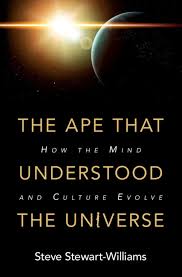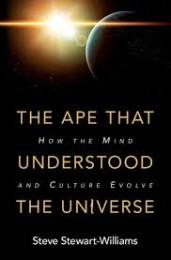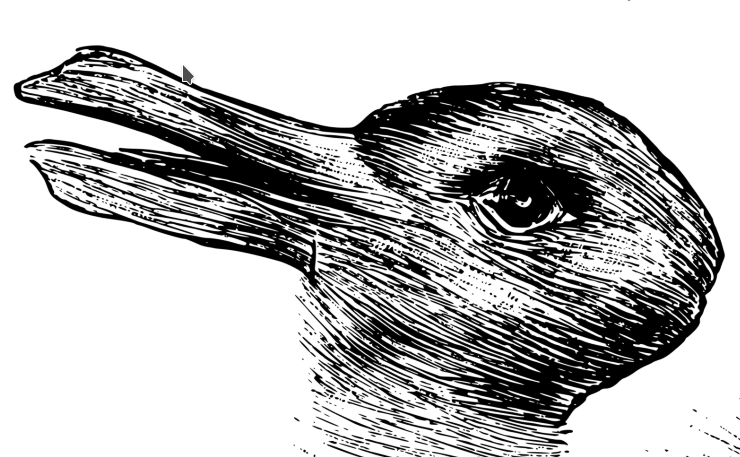
hmmm, yeah but nah : genetics, memetics and an extended West Cork reminiscence of bookish futility
Steve Stewart-Williams, a reading of his The Ape That Understood the Universe: How the Mind and Culture Evolve. (Cambridge University Press, 2018. #ISBN9781108425049 )

General thoughts
I pick this up because it covers some big history, from which general assumptions in my approach to morality and worldbuilding arise. It’s an academic book, as opposed to scholarly. It’s got a great innovation in format of using bolded and boxed hypotheses ranked in order increasing likelihood, for each working half of the book, introducing science’s basic sayings or proverbs, at an elementary level in the book’s structure.
What did I groan through?
This book is what I regard as a general science essay format, and by general I mean it covers the general science of what ever area that is the question the book attempts to deliver on. This means, in this case, if you have read other books on human evolution, there is a certain percentage of mass of the book you do not need to read, except for flavour. I do not necessarily groan through this, but as I am reading the actual title I go ohyearherewego. I suffer repetition badly, and besides saving trees, or saving paper for putting down more amazing stuff, —the books would then take up less space on the shelves, meaning more books… Many well-read or educated readers will nod their heads over these repetitive bits and skip to the gist. If they can find it.
I skipped Chapters 3 and 4 on sex differences and sex and selection.
If it was a narrative non-fiction title in an area I knew little, or knew I knew little, this wouldn’t be a topic to raise, but I do wish we have some modular system where the writer says I use repository X, and in collection Y. and I will draw on the wikiconsesus as far as, but I will fork it… —here.
What was I reminded about?
Axelrod's tournament and tit-for-tat strategies. (Stewart-Williams cites Axelrod, Robert, and Richard Dawkins. The Evolution of Cooperation. Rev. ed, Penguin, 1990, and the 1984 edition.)
What did I reminisce about?
In the early 1990s, I was living in West Cork, Ireland, and in a bookshop in Schull I bought a paperback of Richard Dawkin’s The Extended Phenotype which originally came out in 1982, a decade before. Wherein I read about the meme. Well before it became a meme itself.
Did I make memes then?
No, I neologised “redes” in reaction to The Extended Phenotype.
See Epigenetics, and for which the earliest use in modern genetics was the 90s. I was parallel in time.
Later I tried writing a SF novel with a character call Mark Rede, (that’s you by the way) on a world called Wombwell, (we’re not in Kansas anymore) with a roll-call of marsupials in an alt-colonial pre-Raphaelite dystopia. Everything had Anglish names though, for example, marsupials were all pouchers. I wouldn’t get it published, if it was finished, because it started with an amnesiac main character waking up in the opening scene, I have learned that this is a common enough hackneyed trope to set a publisher’s reader’s eye dead. A more experimental fiction version of the sequel was made available in 2007 at amazon.
In the unpublished work… yes, I still have the drafts somewhere …the amnesiac Mark Rede first encounters a reddleman (no doubt from Wessex) —but wait now, I could maybe put all of those drafts at prompt to a chat AI and get it to write the damn thing.
What can I use?
The EEA or the environment of evolutionary adaptations, which maps to the gene not the expressed individual (plant/animal). It’s an abstract virtual landscape, bit like a fitness landscape in that mental regard of evolution and us/them.
Compare contrast
Redes are more fun than memes, because no one knows what they are.
So what did I learn?
More recent work on intergroup selection and group selection theories. I tend to agree with the author on the possible plausibility of these ideas, and also, that they may not lead anywhere. So I suspend myself in non-judgement and wait further research.
While Feuerbach said something similar a long time ago I really liked Stewart-Williams quoting Peter Frost’s “Man has made religion in his own image, but religion has returned the favour.” from the post The fellowship instinct. (Peter Front also now has a substack. I used to be on blogspot too, and that’s how I was invited to have one of the very early gmail addresses.)
That while something can be quite neat and logical, and it may well have good analogies elsewhere, that doesn’t mean you can throw it in the gap. See reaction below.
So on this I meta-learned, that it doesn’t have to be supported by a bias (personal or inconscious) to be thrown into the… —gap.
Throwing stuff into the gap is not a pathology.
Not always.
Reaction?
I may have played with memes and memetics, but the use of it by analogy with genes and genetics and Darwinian evolution, to somehow throw into the gap as solution in the world we live in as human consciousness arising out of evolution— is unlikely. I don’t have any trouble with the logic outlined in this book, nor it’s clink-clack tick-tock hypothesis, and has a good or two lead to test, both experimentally and in thought experiments.
My suspicion is that we don’t yet have the right framework to ask what will be, eventually, an obvious question.
So the evolutionary psychology in the first half of the book, which lays the ground work for the second, I do not have a huge problem with, per se, but the drawing out of its methodologies into memetics as a cultural evolutionary theory, does not grab me. And this is not because it is incoherent, or implausible. No doubt some of its leads will provide interesting engagements with the world. But despite the consistency, it may end up more an art, which many sciences end up when they are not even wrong, as we work out the wisdom of the world, that extended phenotype we worry about by all other means at hand… futility in action.
This is the same as my regard of a experiment-in-thought with a focus on groups for selection, i.e. using what works in one frame (the individual as gene or expression in Darwinian evolution) within another framework where they might kinda work (either group selection or memetics). Obvious one’s lead to the other but… —the gap.
So the first half of the book I groaned through, and the second I went hmmm, yeah, but nah.
I think the key here for me is how painful we trudge through possible altruism theories and their ethical examples and taxonomies. I mean, why is that so hard when it is so easy to should on people? Only prejudical survival enhancing prejudices? But there is a world out there, where did that come from?
I say you should it.
But, how to turn that into the right question?
substack version from February 2023.
